Enables characterisation of the thermal denaturation of proteins or other biomolecular assemblies such as DNA or micelles. Enables accurate characterisation of the melting temperature, and under favourable circumstances, other thermodynamic parameters of protein folding or complex disassembly. The (de)stabilizing effects of buffer additives such as detergents can be assessed. Comparison of results with and without binding partners enables determination of binding affinities in cases of very high affinity where other methods may fail. The technique does not require any labelling or modification of materials and is largely independent of molecular size.
What are the sample requirements?
- Pure samples are required.
- Concentrations are typically 20 μM for protein or 200 μM for nucleic acid
- A MicroCal/MalvernPanalytical VP-DSC instrument requires 0.85-1.5 mL protein solution per sample and a higher-throughput VP-Capillary-DSC 0.25-0.4 mL per sample. The higher concentrations are convenient, to avoid bubbles or issues with automatic handling
- Macromolecules should be dialyzed exhaustively against buffer to ensure that sample and reference solutions are exactly matched.
- Samples and buffer degassing is required to avoid air bubbles.
What other specific considerations are relevant?
- Buffer should have a low enthalpy of ionization (e.g., glycine, sodium/potassium acetate, sodium/potassium phosphate, sodium cacodylate, sodium citrate). Tris, PIPES, HEPES and MES should be avoided.
- High concentrations of solubilizing agents (e.g., glycerol, DMSO) should be avoided.
- Reducing agents cause artefacts; DTT must be avoided and TCEP or β-mercaptoethanol should be < 5 mM and preferably much lower.
- Fluoride-containing samples cause irreparable damage to the DSC cell, their use is prohibited.
Partners offering this technique
MOSBRI reference partner site for this technique:
Other partners:
